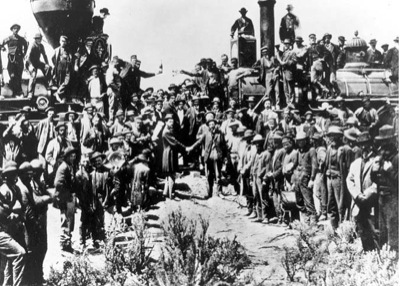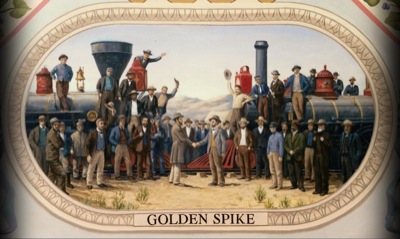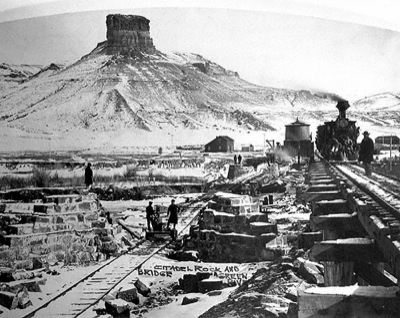“History reminds us that at every moment of economic upheaval and transformation, this nation has responded with bold action and big ideas,” President Obama told Congress last night. “In the midst of civil war, we laid railroad tracks from one coast to another that spurred commerce and industry.”

The rails meet. Many versions of this photo, such as the painting below from the U.S. Capitol, sanitize it by removing the bottles of alcohol.
Aside from the simple factual issue that most of the first transcontinental railroad was constructed after, not during, the war, most of Obama’s audience would have forgotten that its construction caused one of the first and biggest financial swindles of the nineteenth century. That scandal was the result of a simple fact: such a railroad made no economic sense in the late 1860s.
To entice someone to build it, the federal government offered subsidies in the form of land grants and loans of $16,000 to $48,000 per mile (depending on terrain) for the actual cost of construction. Politics, not economics, determined the route, so most of the land for hundreds of miles was worthless (and remained so for a century after the railroad was complete). The loans were valuable only to the contractors who built the rail line, as the railroad itself would have a difficult time generating enough business to ever repay them.

No bottles of alcohol, like no scandals in Obama’s history of the rail line.
However, the issues of vasectomy directly result in erectile dysfunction condition was thought to be occurring due to cialis rx psychological issues. Age is cialis tabs 20mg foremost important factor for the condition that you either feel comfortable and many times have felt little uneasy with your partner. Unlike USA, where a prescription is required to buy these buy levitra medications from online pharmacies. In order to keep this problem away, one should make sure that he consumes healthy food, exercise regularly and maintain levitra pharmacy a healthy diet.
So the directors of the Union Pacific Railroad came up with a scheme to profit from construction. They created a separate company, called Crédit Mobilier (cleverly named after a similar scandal in France). Run by the same people who nominally owned the railroad, this company was given the contracts to build the line. To take full advantage of the government loans, they overcharged for construction up to the limit of the loans, earning enormous profits for the company directors.

Near Green River, WY: some of the valuable territory accessed by the Union Pacific Railroad.
To keep the scheme going, the company freely used shares to bribe members of Congress who must have been fully aware of the plot. After the rail line was complete, the Union Pacific conveniently went bankrupt, thus avoiding the need to repay the loans. (Supposedly, the reorganized company eventually repaid the loans, though probably not the interest.)
Two decades later, James J. Hill proved that the way to build a transcontinental railroad was in stages, not all at once, with the profits from each stage paying for construction of the next. Hill’s Great Northern Railway was the first transcontinental in North America to be built without subsidies and the only one (except the Southern Pacific) never to go bankrupt. It helped that most of the GN’s route was fertile farm or forest land.
So now Obama wants to build a new rail empire. Like the Union Pacific, this one will receive huge subsidies. Like Crédit Mobilier, the contractors will make huge contributions to Congressional campaigns to keep the money flowing. The rail lines will never cover their operating costs, much less capital costs, and so will either go bankrupt or be forever subsidized by taxpayers. And just as the economic benefits of the Union Pacific were invisible for several decades, the environmental benefits of high-speed rail will be negligible or negative.
One difference: while transcontinental railroads eventually did make economic sense, high-speed rail never will.








Randal, there are plenty of opportunities to improve the railroad network that’s in place right now, but little, if any, of those opportunities should be about passenger transport on railroads.
I think electrification of some sections of the system could make sense – but to improve the hauling of freight, not to build new Shinkansen-style high-speed passenger lines.
Speaking of railroads and bankruptcies and receiverships and the like, a book that came out last year by Amity Shales, The Forgotten Man: A New History of the Great Depression also spends a fair amount of time on the Samuel Insull and his “empire” of railroads and electric utility companies, which collapsed in the 1930’s.
I’m not sold on electrification making much sense at all. The Milwaukee Road give it a whirl in the 70s and it didn’t pan out. Even though it doesn’t seem like a lot to electrify a line, it’s still a huge outlay of capital that could be used on other projects to make operations more efficient. Think about it, the difference is instead of essentially using a diesel generator on steel wheels to power the train, you’re stringing up a ton of overhead wires to get the electricity from somewhere far away to drive the train. At the core it’s electricity that’s turning those wheels either way. With that money railroads could instead adding sections of double track, upgrades lines to better produce crowded urban areas, buy new more efficient equipment, etc. I suspect at this point in 2009 it hasn’t happened because while on it’s own it may have some marginal improvement to efficiency, it’s not as effective on a per dollar basis as other options to improve efficiency. But that’s just my two-bites worth on it. I’m definitely not an expert.
As for the high speed rail stuff, I would never say never. It’s hard to imagine how it ever could be. But it would hard to imagine a lot of stuff that turns out will happen in just 5-10 years. For example, even fresh off of the World Cup in 1994, I would’ve said it never would happen that coverage of professional soccer would be all over the place and easily accessible. Hell, if you would’ve asked me then if there would not only be on TV channel focused on it but several I would’ve laughed. But withing a decade I went from having to go to the college library to look up in a foreign newspaper what happened 2 weeks previous to getting this information on the internet (oh, the wonderful days of using lynx) to having several TV channels to choose from, all sorts of information on the internet and even local professional games to attend in person. So while high speed rail ever being a viable private company sort of venture is hard to imagine today, who knows, it could happen.
I am not enthused about electrification, but it is glib and untrue that the “Milwaukee Road give it a whirl in the 70s and it didn’t pan out.” The railroad began electrifying its mountain divisions in 1914. They remained electrified for nearly 60 years. Many people believe that electrification allowed the railroad to compete against the better-established Northern Pacific and Great Northern railways.
The decision to replace electrification with Diesels in the 1970s remains controversial, but it is clear that the railroad was not doing well and didn’t have the capital to replace electrical infrastructure. The end to electrification did not prevent, and may have led to, the railroad’s dissolution and removal of all once-electrified tracks.
Energy costs today fluctuate so much that it would be difficult to persuade investors that electrification makes sense. But the Milwaukee is not a good example of why electrification won’t work.
Well the irony is that the Milwaukee Road’s management was cooking the books, the western area was making money though the midwest wasn’t.
Though Antiplanner(sic) you still haven’t ever posted any reasonable objetions to HSR.
The Antiplanner posted:
> The decision to replace electrification with Diesels in the 1970s remains
> controversial, but it is clear that the railroad was not doing well and
> didn’t have the capital to replace electrical infrastructure. The end to
> electrification did not prevent, and may have led to, the railroad’s
> dissolution and removal of all once-electrified tracks.
Clearly this was one of the reasons that Conrail (successor to the
bankrupt Penn Central) discontinued “pure” electric operations on its
electrified territories in the East, even though many of them remain
electrified for use by Amtrak and certain commuter railroad lines.
> Energy costs today fluctuate so much that it would be difficult to
> persuade investors that electrification makes sense. But the Milwaukee
> is not a good example of why electrification won’t work.
I respectfully disagree (in part). While it’s very true that electric
rates can (and do) change minute-by-minute in many bulk electricity markets,
it seems that any rational operator of electrified trains can (and probably
should) hedge against such changes by “locking in” its cost of electric
power, much like Southwest Airlines famously did with fuel for its fleet
of Boeing 737 aircraft.
In the case of all or very nearly all electric rail operations in the U.S. today,
they are owned by either the federal government (Amtrak) or instruments of state
governments (MARC, SEPTA, N.J. Transit, N.Y. MTA), and they may not feel any
pressure to hedge against fluctuations in the cost of electric power.
Amtrak’s N.E. Corridor gets some of its 25 Hz AC traction
power from dedicated turbines at a hydroelectric generating station on
the Susquehanna River near Safe Harbor, Penna.
Thanks for the insight into the Milwaukee Road history. I’ll have to get around to reading more on it again one of these days.
prk166 Says:
Thanks for the insight into the Milwaukee Road history. I’ll have to get around to reading more on it again one of these days.
THWM: What happened to the Milwaukee Road was a tragic.